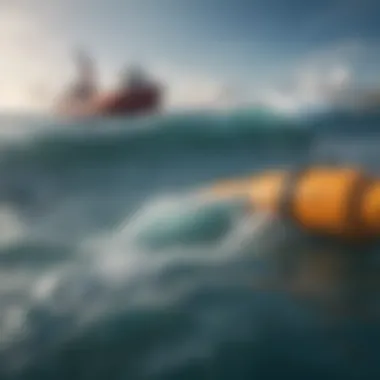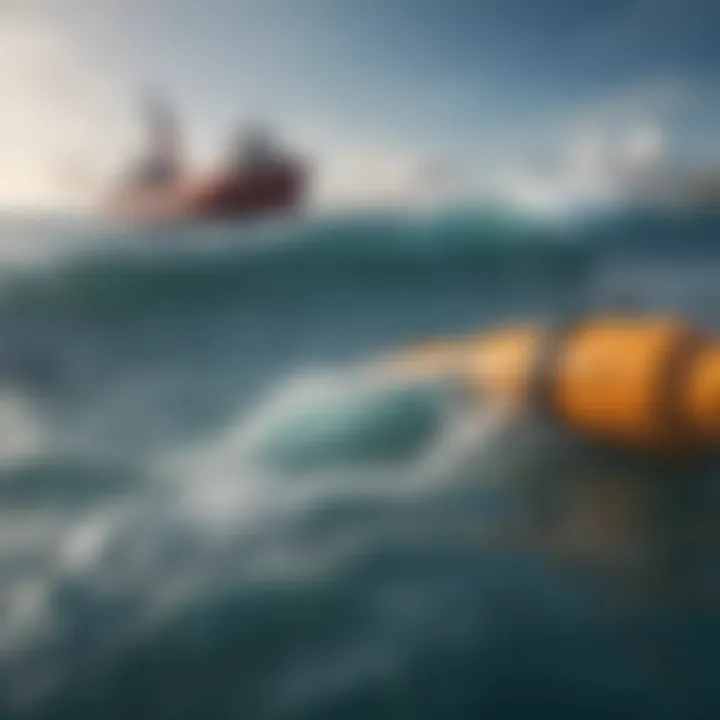Challenges of Ocean Pollution: Insights and Solutions


Intro
As humanity grapples with an array of environmental challenges, pollution in our oceans looms as a pressing concern. This issue extends beyond the mere presence of waste in our seas; it encompasses a variety of harmful substances, ranging from plastics to toxic chemicals, that threaten marine ecosystems and public health. These pollutants infiltrate the waters, disrupting the delicate balance that sustains countless species and, by extension, the communities that rely on them.
The effects of ocean pollution are manifold and often insidious. Fish ingest microplastics, leading to health concerns both for the creatures themselves and those who consume them. Increasing levels of chemicals like mercury and lead not only compromise marine life but also pose significant risks to humans, particularly those in coastal regions whose diets may heavily feature seafood. As such, understanding the challenges posed by these pollutants is crucial for surfers, marine biologists, and anyone invested in the well-being of our oceans.
This article aims to shed light on the complex world of ocean pollution, exploring its causes, the impact on marine life, and potential mitigation strategies. We will discuss regulatory frameworks that are in place, the role of community engagement in tackling this crisis, and innovative solutions being implemented worldwide to address these pressing concerns. Through comprehensive analysis, we hope to spark awareness and motivate action among surfers and the general public alike.
In each subsequent section, we shall unpack the layers of this multifaceted issue, drawing connections between pollution, surfing practices, and the health of our oceans. Let's embark on this deep dive into the choppy waters of ocean pollution.
Prolusion to Ocean Pollution
The oceans cover more than 70% of our planet, serving as critical ecosystems for countless species. Sadly, they are also becoming dumping grounds for a variety of pollutants. Understanding the importance of ocean pollution is crucial not only for marine life but for our wider environment and, ultimately, ourselves. The waters we surf or relax beside play a significant role in maintaining the balance of Earth's ecosystems.
Chemical substances, plastics, and other contaminants are finding their way into these precious ecosystems, causing considerable harm. This article aims to explore these alarming challenges, highlighting why we should all be concerned about the state of our oceans.
Defining Ocean Pollution
Ocean pollution refers to the introduction of harmful substances or agents into the marine environment. These pollutants can originate from various sources, including industries, agriculture, and even our own everyday activities. When we throw things into the ocean, we often underestimate the impact of such actions. Garbage thrown on the beach might wash away, but it can eventually end up harming marine creatures.
Different forms of ocean pollution can be categorized, including plastic pollution, chemical spills, and oil leaks. By clearly defining ocean pollution, we begin to appreciate the significance of our actions and their far-reaching effects. When we disyregard the seriousness of marine pollution, it’s like ignoring a crack in a dam – sooner or later, that crack is going to lead to bigger problems.
Historical Context and Trends
As civilization has advanced, so too has the pressure on our oceans. The post-World War II era marked a significant turning point. Industries flourished, and with them came an increase in waste production. Fast forward to the present day, and ocean pollution has reached staggering proportions. According to research, nearly 8 million metric tons of plastic waste enter the oceans each year, a trend that has shown no signs of abating. This highlights a growing issue across decades.
In the early 20th century, the impact of dumping waste into oceans was largely ignored. Public awareness was low, and regulatory measures were primitive. But the tides began to turn as the environmental movement gained momentum during the 1960s and 70s. Landmark events, such as the first Earth Day in 1970, sparked a new consciousness about environmental preservation, including ocean health. Although steps have been taken over the years to address the issue, the ongoing trend of neglect remains worrying.
"The sea, once it casts its spell, holds one in its net of wonder forever."
– Jacques Cousteau.
As we delve deeper into the realities of ocean pollution, it becomes evident that addressing these challenges is not merely an option but a necessity for ensuring the sustainability of marine ecosystems for years to come.
Types of Ocean Pollution
Understanding the various types of ocean pollution is crucial to grasping the broader issues regarding the health of our seas. Each category of pollution presents unique challenges and consequences that require tailored strategies for management and eradication. This section will outline the prominent types, focusing on specific pollutants like plastic, chemicals, and marine debris. By delving into these areas, we can recognize not only the gravity of the situation but also the impetus for action.
Plastic Pollution
Plastic pollution is one of the most visible and alarming aspects of ocean pollution. It manifests in two significant forms: microplastics and macroplastics, each contributing profoundly to the pollution narrative.
Microplastics
Microplastics, defined as tiny plastic particles less than five millimeters in size, often result from the breakdown of larger plastic items. This specific aspect highlights how even small fragments wreak havoc far beyond their size.
Microplastics might seem benign due to their minute scale, but they persist in the environment and transfer toxins through marine ecosystems. According to research, microplastics are capable of absorbing harmful chemicals, which can then bioaccumulate in marine species.
A unique feature of microplastics is their abundance. They have proliferated through everyday activities — think about common clothing washing that releases microfibers or the breakdown of cosmetic products. One downside is that they are nearly impossible to filter out, making their impact widespread and reversible only by holistic environmental approaches.
Macroplastics
Macroplastics refer to larger plastic items, such as bags, bottles, and fishing gear, that can be seen floating in the water or washed up on beaches. Their immediate visibility makes macroplastics a poignant symbol of human negligence in ocean stewardship.
The key characteristic of macroplastics lies in their size and the harm they pose to marine life. They can entangle sea animals, restrict their movement, and even lead to their fatalities.
A unique feature of macroplastics is their durability. Unlike organic waste, which breaks down relatively quickly, these materials persist for years, releasing toxins in the process. Thus, it's clear that while some might view macroplastics as merely litter, their consequences are anything but trivial.
Chemical Pollutants
Chemical pollutants present another severe form of ocean pollution, encompassing harmful substances like pesticides and heavy metals. Each plays a detrimental role in marine habitats and extends to human health.
Pesticides


Pesticides can runoff from agricultural lands into rivers and ultimately the ocean, where they disrupt ecosystems. Their specific aspect showcases how these chemicals can unintentionally affect species far removed from their intended targets.
What sets pesticides apart is their toxicity—many are designed to eliminate pests but can also be lethal to marine creatures. Their entry into ocean waters can lead to bioaccumulation and biomagnification through food webs, posing health risks to both marine species and humans alike. While they address agricultural needs, their unintended consequences are a pressing concern we can't oversight.
Heavy Metals
Heavy metals, such as mercury and lead, often leach into ocean waters from industrial processes and urban runoff. Their specific aspect of persistence highlights how these metals do not degrade over time, leading to increased concentrations and toxicity.
The key characteristic of heavy metals is their ability to accumulate in the tissues of marine organisms, leading to serious health issues and declining populations. One of their major disadvantages is the long-term implications they have for food safety and human health, especially when high concentrations enter the food chain. The choice to overlook their presence is a risk we cannot afford to take.
Marine Debris
Marine debris encapsulates all the garbage that ends up in our oceans and often includes items we use daily, such as plastic and metal products. Among its categories, fishing gear and various waste products are particularly concerning.
Fishing Gear
Abandoned or discarded fishing gear, known as 'ghost gear,' represents a tragic source of pollution with substantial ecological consequences. The specific aspect of ghost gear highlights how these objects can continue to catch and kill marine life long after they’ve been lost.
A key characteristic of fishing gear is its design and durability; typically made from strong materials, it doesn’t easily break down in aquatic environments. One unique feature of this gear is that it contributes directly to the death of countless marine animals, not just through entanglement but also because of habitat disruption.
Various Waste Products
Various waste products is an all-encompassing term describing everything from household trash to industrial byproducts. Their specific aspect reflects the myriad origins of ocean pollution and the complexities of addressing such a failure of waste management.
A key characteristic of these waste products is their diversity, which complicates cleanup efforts. The unique feature here is that depending on the material, different types of waste can leach toxins into water, presenting both physical hazards and chemical threats to marine life. The reality is, these debris pose a greater challenge in our efforts to maintain healthy oceans.
In essence, each type of ocean pollution poses distinct challenges that need attentive examination and proactive measures. A comprehensive understanding of these categories is the first step toward effective mitigation and improved ocean health.
By breaking down each type, we can better pinpoint how to make significant changes and protect our marine environments.
Sources of Ocean Pollution
Understanding the sources of ocean pollution is key to addressing the problems that plague our marine environments. By identifying the origins of contaminants, we can devise strategies to mitigate their impacts. From industrial discharges to agricultural runoff, these sources not only threaten marine biodiversity but also harbor significant implications for human health, economies, and the overall health of our oceans.
Industrial Discharges
Industrial discharges represent a major factor contributing to ocean pollution. Factories often release untreated or inadequately treated waste into nearby waterways, which can eventually flow into the ocean. These discharges may contain harmful chemicals—like solvents, heavy metals, and other toxic substances—that wreak havoc on marine life.
For instance, the effluents from manufacturing plants can lead to bioaccumulation of toxins in fish, which poses a significant risk to those who consume them. The consequences of this include not only diminished fish populations but also severe health issues for local communities reliant on fishing for sustenance.
"An ounce of prevention is worth a pound of cure”—this saying holds true when discussing industrial pollution. Enforcing stricter regulations on industrial waste disposal can drastically reduce ocean contamination.
Agricultural Runoff
Agricultural runoff is another critical source of ocean pollution. When it rains, fertilizers and pesticides used in farming wash off fields and into rivers and streams, ultimately making their way to the ocean. This runoff introduces nutrients, such as nitrogen and phosphorus, into the marine environment, leading to harmful algal blooms that deplete oxygen levels in water.
The increased nutrient levels can lead to
- Dead zones where marine life struggles to survive.
- Coral bleaching, affecting the health of vibrant coral reefs.
- A decline in fish populations, impacting those who depend on fishing industries.
Addressing agricultural runoff involves adjusting farming practices. The adoption of sustainable agricultural techniques, such as crop rotation and reduced fertilizer application, can play a crucial role in curtailing runoff.
Wastewater Treatment Issues
Another pressing concern is the shortcomings in wastewater treatment processes. Inefficient treatment plants sometimes fail to filter out all contaminants before discharging water back into the marine environment. This inadequacy leads to a cocktail of pollutants reaching the oceans, including pathogens, pharmaceuticals, and microplastics.
Such issues not only endanger marine ecosystems but also jeopardize human health when contaminated water enters the food chain. Moreover, the presence of microplastics in wastewater poses a complex challenge, as their breakdown has proven difficult, allowing them to persist and accumulate in ocean sediments.
Steps to improve wastewater management include upgrading treatment facilities and promoting green infrastructure, which mimics natural systems to improve water quality. By investing in better technologies, we can minimize the rate at which pollutants enter our oceans, leading to healthier water and, ultimately, a more sustainable ecosystem.
Impact on Marine Ecosystems


The impact of ocean pollution on marine ecosystems is vital to understand. Marine ecosystems comprise intricate networks involving countless species, habitats, and interactions. When pollution seeps into these systems, it creates tremors that can disrupt the balance, leading to far-reaching consequences. Marine life not only suffers but so do human communities that depend on the ocean’s riches.
Effects on Biodiversity
Biodiversity is the backbone of resilient marine ecosystems. It encompasses the variety of life in the oceans, including plants, animals, and microorganisms. Pollution diminishes this variety in several ways. Pollutants, like plastics and chemicals, can alter habitats and reduce reproductive success among species. Take coral reefs, for instance; they thrive in clean waters, but pollution often leads to coral bleaching events that devastate these vital structures.
The reduction in biodiversity means fewer species to maintain ecological balance. This loss can result in a domino effect where one affected species may elicit changes in others, leading to further declines.
"A decline in key species like sharks, which regulate the populations of smaller fish, can lead to overpopulation of prey species, which in turn affects the overall health of the ecosystem."
Habitat Degradation
Habitat degradation speaks volumes about how pollution affects marine ecosystems. Coral reefs, mangroves, and seagrass beds serve as essential habitats for many organisms. Yet, chemical runoff can smother these ecosystems, reducing their effectiveness and even wiping them out over time.
For example, nutrient overload from agricultural runoff can lead to algal blooms. These blooms can block sunlight and lower oxygen levels, creating dead zones unfit for most marine species. Over time, this degradation chips away at the very foundation on which countless marine species depend. The repercussions include not just loss of habitat but also declines in population numbers, diminishing the chances of recovery.
Trophic Cascade Effects
The idea of trophic cascades turns the spotlight on interconnected relationships among marine species. When certain predator populations decline through pollution, prey populations can explode, drastically changing community structures.
Consider the sea otter: an apex predator that helps control kelp-eating sea urchins. If pollution reduces otter populations, urchins can proliferate unchecked, leading to overgrazing of kelp forests. This, in turn, can deplete habitats critical for countless marine species. Such cascading effects highlight that altering even one component in a marine ecosystem can result in a chain reaction, leading to unpredictable outcomes.
Trophic cascades underscore the complexity of marine ecosystems and how they can be fragile in the face of pollution. Protecting biodiversity and restoring habitats are thus paramount not only for today’s ecosystems but also for future sustainability.
Health Risks Associated with Ocean Pollution
Understanding the health risks associated with ocean pollution is crucial for both public awareness and policy-making. The contamination of oceans has far-reaching effects, not just on marine life but also on human health and economies. This section explores the two primary aspects of health risks: the impact on food safety and toxic exposure, shedding light on how these factors threaten individuals and communities relying on ocean resources.
Impact on Human Health
Food Safety Issues
Food safety issues arise when harmful pollutants make their way into the seafood that many depend on for sustenance. Contaminants such as mercury and polychlorinated biphenyls (PCBs) can accumulate in fish and shellfish, posing a danger to consumers. One key characteristic of these food safety concerns is that they often affect vulnerable populations, including young children and pregnant women, who may suffer severe health consequences from consuming contaminated seafood.
Why focus on food safety? Because it directly links to the public’s dietary habits and overall health. The unique feature of food safety issues lies in the presence of hazardous substances that can persist in the environment and biological systems over long periods. This persistent nature of contaminants means that ongoing monitoring and rigorous testing of seafood are necessary, and unfortunately, such measures are often not adequately implemented.
Thus, recognizing and addressing food safety issues is vital for safeguarding health. The advantages include protecting consumers and maintaining the integrity of local fishing industries and tourism. However, the disadvantages stem from the potential economic repercussions on small fishermen and communities dependent on ocean products if contamination leads to widespread avoidance of seafood consumption.
Toxic Exposure
Toxic exposure is another critical dimension tied to ocean pollution. This aspect covers a range of harmful substances like heavy metals and organic pollutants that can leach into seawater and eventually enter the human body through various pathways. When boaters, surfers, or coastal residents come into contact with polluted water, they may unwittingly increase their risk of developing serious health issues, including skin irritations, respiratory problems, and even long-term illnesses such as cancer.
A striking characteristic of toxic exposure is how it can quietly influence health over time, sometimes without immediate symptoms. This insidious nature makes it difficult to establish direct links between exposure and specific health outcomes. The unique problem is that the pollutants frequently found in ocean water may not be entirely eliminated through conventional water treatment processes.
Advantages include raising awareness about the dangers of engaging in water-related activities in polluted areas; however, the challenge lies in providing clear guidelines for different risk levels and establishing public health safety nets in vulnerable regions.
Economic Consequences
The economic fallout from ocean pollution is felt particularly in two critical sectors: fishing industries and tourism. Each carries its own weight in terms of local and national economies, and both are heavily influenced by the quality of oceanic resources.
Fishing Industries
Fishing industries are directly threatened by ocean pollution as contaminated fish populations dwindle or decline due to decreased reproductive success and vitality. When fish are found to be polluted, it can result in bans on fishing or increased regulations that impact the livelihoods of fishermen. This situation can ultimately lead to job loss and diminished economic stability in coastal communities.
Highlighting the central role of fishing industries in local economies underscores why they deserve attention in discussions about ocean pollution's impacts. The unique feature here is the balance between sustaining a thriving fishing industry and ensuring the safety of the seafood that reaches consumers. While sustainable practices can potentially combat pollution's effects, the struggle lies in enforcing regulations and providing support for fishermen to shift practices without going belly up financially.
Tourism
Tourism often thrives in coastal regions, attracting visitors drawn to beautiful beaches and the promise of recreational activities in the ocean. However, polluted waters can quickly turn a vibrant tourist destination into a ghost town. Tourists avoiding contaminated areas to dodge health risks can severely affect local economies that rely on visitor spending.
A noteworthy aspect of tourism is its sensitivity to perceptions of safety and cleanliness. When the ocean is viewed as contaminated, it can discourage potential visitors from choosing that destination, leading to loss of income for small businesses and local governments alike. The unique challenge is reviving interest in these areas once pollution events subside, as it often requires extensive marketing efforts and rehabilitation of natural resources.


In summary, both the health risks and economic consequences stemming from ocean pollution present serious challenges. By increasing awareness and advocating for change, surfers, coastal residents, and communities can play a pivotal role in protecting their waters and ensuring a sustainable future.
Mitigation and Management Strategies
Regulatory Frameworks
International Agreements
International agreements play a crucial role in tackling ocean pollution on a global scale. These treaties and protocols establish baseline standards, enabling nations to collaboratively manage and mitigate the spread of pollutants across national boundaries. For instance, the United Nations Convention on the Law of the Sea (UNCLOS) has become a cornerstone in regulating marine pollution. It outlines principles such as the duty to prevent and control pollution from various sources, including ships and land-based activities.
One key aspect of international agreements is their ability to foster global cooperation. By establishing a common set of rules, they encourage countries to work together, share research data, and develop joint initiatives. This collective approach not only bolsters regulatory capacity but also instills a sense of joint responsibility among nations. A unique feature of these agreements lies in their implementation mechanisms, which can vary in effectiveness based on the political commitment of the countries involved. While many nations strive to meet these guidelines, enforcement remains a challenge due to differing national interests and capabilities.
National Policies
National policies are pivotal in addressing ocean pollution, as these laws and regulations dictate how countries approach environmental protection within their jurisdictions. A significant characteristic of national policies is their tailoring to local conditions, which helps address region-specific pollution sources effectively. For example, countries like Norway and Japan have established robust legal frameworks to manage plastic waste, which contribute significantly to ocean pollution.
These tailored approaches allow for innovative solutions adapted to the unique challenges facing different coastal regions. However, one cannot ignore the limitations of national policies; these can often lead to inconsistencies if not harmonized internationally. Disparities in enforcement mechanisms between countries may lead to a pollution haven effect, where stringent regulations in one country push polluters to less regulated jurisdictions.
Community-driven Initiatives
Beach Clean-ups
Beach clean-ups serve as grassroots movements that mobilize community participation to address litter and waste directly affecting coastlines. They act as a form of public engagement, fostering a sense of ownership and stewardship over local environments. These initiatives not only remove visible pollution, such as plastics and debris, but they also raise awareness about the pervasive nature of ocean pollution among participants.
A unique aspect of beach clean-ups is their ability to draw diverse groups together, from local residents to tourists. Such collective action creates shared experiences that can lead to enduring community action against pollution. However, while they contribute positively, these clean-ups are often seen as band-aid solutions that don’t tackle the root causes of pollution. They may lead to significant beach improvements but do little to change broader systemic issues without supportive policies or educational backing.
Educational Programs
Educational programs about ocean pollution are essential for raising awareness and informing future generations. These initiatives can range from classroom discussions to community workshops, aimed at equipping individuals with knowledge about sustainable practices. One significant characteristic of educational programs is their long-term impact; informed communities often demonstrate proactive behaviors towards pollution reduction.
The unique feature of such programs lies in their versatility; they can be tailored to various audiences, from schoolchildren to adults. This adaptability makes educational programs a favored choice for fostering environmental stewardship. Nevertheless, the effectiveness of these educational initiatives can diminish if not paired with actionable avenues for individuals to apply what they've learned. Without local or governmental support to implement changes, knowledge alone may not yield the intended results.
Innovative Technologies
Bioremediation Techniques
Bioremediation techniques leverage natural processes to combat ocean pollution. Utilizing microorganisms, such as bacteria and fungi, these methods can break down harmful contaminants, transforming them into less harmful substances. This approach offers a sustainable alternative to traditional chemical clean-up methods, which may introduce additional environmental stressors.
A notable characteristic of bioremediation is its eco-friendliness and potential cost-effectiveness. Successful bioremediation projects have been documented worldwide, displaying its promise as a viable solution. However, challenges remain in addressing the efficacy and time required for these techniques, as not all contaminants respond equally to bioremediation efforts; thus, judicious selection of sites for application is crucial.
Advanced Waste Management Systems
Advanced Waste Management Systems incorporate innovative technologies and strategies to mitigate waste generation and improve disposal methods. These systems promote recycling, waste-to-energy conversion, and smart waste tracking. A significant feature of these advanced systems is their ability to integrate real-time data analytics, helping municipalities optimize waste collection and disposal processes.
The trend towards such systems has proven beneficial, as they effectively decrease the amount of waste reaching the oceans. However, implementation can be costly and requires substantial initial investments, often making it difficult for under-resourced communities to adopt them. Furthermore, technological solutions must be balanced with community engagement to be successful, as the best systems rely on informed participation.
End and Call to Action
Understanding ocean pollution is not just an academic exercise; it’s a clarion call for action. The delicate balance of marine ecosystems is under threat, and the implications shoot far beyond the waves. If we ignore these challenges, we’re not only compromising marine life but also impacting our own health and economic stability. The quest for cleaner oceans is not a solitary endeavor; it's a collective mission. Each segment of society, from policy makers to surfers, has a role to play in tackling this pressing concern.
Summarizing the Importance of Action
The time for half-hearted measures is long gone. Ocean pollution has far-reaching effects on biodiversity, habitat integrity, and human health. Each day we allow pollutants to seep into our oceans, we write a narrative that endangers countless species. This affects not just the life underwater but also our food supply—fishing stocks are dwindling due to contamination and over-exploitation.
To grasp the scale of the issue, consider these points:
- Marine ecosystems are intricate webs of life. Each disruption adds strain to an already stressed environment.
- Pollutants like microplastics are now a part of the food chain. As they break down, they become increasingly difficult to remove.
- The impacts on human health are wide-ranging, as exposure to toxic substances can lead to severe health risks.
"Our oceans are the lungs of our planet, and their health directly reflects our own; let’s not wait until it’s too late."
Encouraging Responsible Practices Among Surfers
Surfers, in particular, bear a unique connection to the ocean. You’re not just riding waves; you are part of a larger community that relies on clean, thriving waters. Therefore, adopting responsible practices becomes second nature. Here are some suggestions to turn that passion into tangible action:
- Carry your trash. Always bring back what you take to the beach. It seems simple, yet every piece collected has the potential to reduce pollution.
- Choose eco-friendly products. Whether it’s your board wax or sunscreen, select items that are biodegradable or less harmful to marine life.
- Advocate for local cleanup initiatives. Many coastal communities hold regular beach clean-ups, and participation can galvanize others.
- Educate fellow surfers. Share knowledge about the effects of ocean pollution in surf culture, fostering a sense of responsibility within your local surf community.
- Support sustainable tourism. Opt for surfing schools and retreats that prioritize environmental stewardship.
By integrating these practices into your routine, you are not only safeguarding the ocean but also inspiring others to follow suit. Every small step counts towards making waves of change in preserving the beauty and health of our oceans. Together, we can turn the tide and fight back against ocean pollution.















